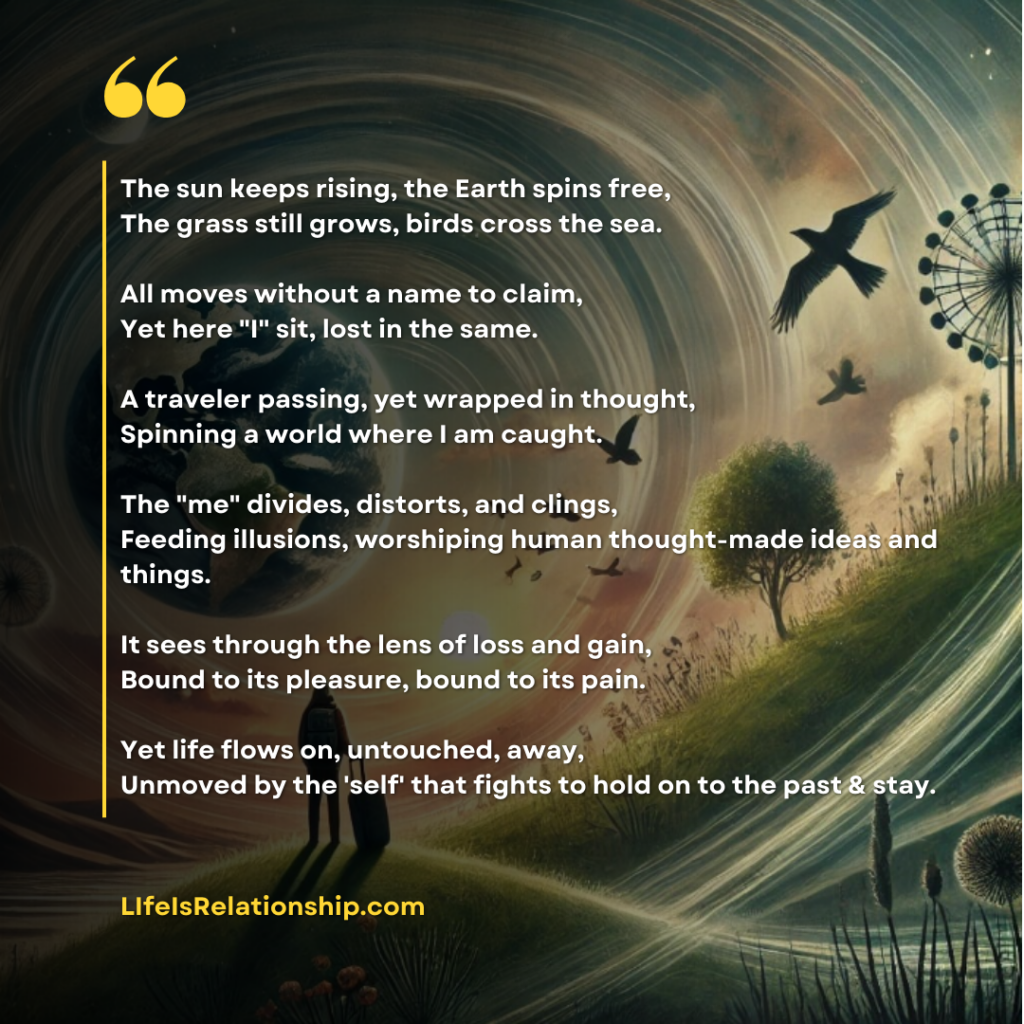
Most of us go through life assuming that there is a constant, stable “me” inside us—an entity that makes decisions, forms opinions, and experiences emotions. But have we ever questioned whether this “me” is real in the way we think it is? Could it be that what we call the “self” is nothing more than a collection of memories, thoughts, and experiences that create the illusion of continuity?
Let’s explore this further.
How the “Me” Comes About Within Each One os Us
1. The “Me” is Memory
Every experience we have leaves an imprint on our minds. These accumulated memories—of pleasure, pain, success, failure—form the basis of our identity. Most of our thoughts arise from “me” centric memories and stories that we told ourselves.
For example, if someone praises you as intelligent, that label gets stored in memory. The next time you are in a discussion, you unconsciously carry that identity and may feel defensive if someone challenges your views.
2. The “Me” is a Story of Becoming
This sense of self is never static. It is always in movement, trying to become something—smarter, wealthier, more successful.
If you’ve ever thought, “I will be happy once I get that promotion,” that’s the “me” projecting itself into the future, believing fulfillment is always just around the corner.
3. The “Me” is Attached to Gain and Loss
We define ourselves by what we have—our possessions, relationships, status. When these are threatened or lost, it feels like we are losing something essential.
Imagine you lose a job. The emotional turmoil isn’t just about financial security; it’s about the “me” feeling diminished, as if its very existence has been shaken.
How the “Me” Creates Conflict
This illusory “me” is the root of much of our inner struggle and external conflict.
1. Comparison and Jealousy
Because the “me” is built on memory and social conditioning, it constantly compares itself to others.
If a friend buys a luxury car, there’s an automatic reaction: “Why don’t I have that?” This comparison creates unnecessary suffering.
2. Fear of Losing What We Identify With
When the “me” is tied to relationships, achievements, or beliefs, any threat to these feels like an attack on ourselves.
A simple disagreement with someone can escalate into anger—not because of the issue itself, but because the “me” feels challenged.
3. The Endless Search for Security
The “me” craves psychological security, but since life is always changing, it never finds lasting peace.
No matter how much success we achieve, there’s always an underlying anxiety: What if I lose it? What if it’s not enough?
What Happens When the “Me” is Not Active?
If this “me” is nothing more than a construct of thought, what happens when it is not at the center of our experience?
1. Freedom from Comparison
If you stop identifying with an image of yourself, there is no need to compare. You simply live, without measuring yourself against others.
Imagine watching a sunset. In that moment, there’s no sense of “me” comparing it to past experiences—it’s just beauty, experienced directly.
2. No Psychological Fear
When the “me” is not at play, fear loses its grip.
You might still take practical precautions in life, but the inner fear of not being “good enough” or “losing status” disappears.
3. Love Without Attachment
Love, in its purest form, is not about possession. When the “me” does not cling to relationships for its own security, there is genuine affection and care—without fear, jealousy, or dependence.
Observing the Movement of the “Me”
The point is not to suppress the “me” or fight against it—that would just be another action of the same self-centered thought. Instead, can we simply watch how this “me” operates?
1. Notice how thoughts create identity
The next time you feel hurt, ask: What is actually feeling hurt? Is it the direct experience, or is it the idea of “me” being challenged?
2. See how the mind clings to labels
When you call yourself “successful” or “a failure,” recognize that these are just ideas based on past conditioning.
3. Observe without judgment
Instead of trying to change your thoughts, just watch them—like watching clouds move across the sky. In this observation, something shifts.
The Role of Awareness and Quietness
Now, what happens when this movement of thought—the constant projection of the “me” into the future, its endless search for security, its habitual patterns—begins to slow down?
1. Seeing the Illusion of Continuity
The mind assumes that the “me” is a continuous entity, but in reality, it is just a stream of thoughts, each moment creating a new version of itself.
Imagine a movie reel: it appears to be a smooth, continuous story, but in reality, it is just a series of separate frames. The same is true for the self—it only feels continuous because thought keeps reviving the past and projecting the future.
2. When Thought Loses Its Grip
The “me” survives by keeping the mind busy—chasing desires, fearing loss, planning futures that may never happen. But when we become deeply aware of this process, thought starts losing its momentum.
Think of a spinning fan: if you stop giving it power, it doesn’t halt instantly, but it slows down on its own. The same happens with thought—it loses its authority, its intensity.
3. The Arrival of Quietness
This quietness is not something we can achieve—it is what naturally remains when the “me” is not dominating our perception.
It is not a forced silence, like trying to meditate to quiet the mind. It is the silence that arises when we see, with absolute clarity, how the mind keeps inventing a false sense of self and mistaking it for something real.
Reflection
When we deeply observe the workings of the “me,” its movements become transparent. We see how thought creates and sustains an illusion of self, projecting images of security where there is none, fearing loss where there is nothing real to lose.
And when this whole movement slows down—not by force, but through clear awareness—something profound takes place. A quietness, not of suppression but of deep clarity, arises.
This quietness is not emptiness—it is the awareness that the entire structure of the self is a construct of thought. And in that awareness, there is no need for control, no need for struggle. There is only seeing, and in seeing, there is freedom.
Can we simply watch—without trying to change, without seeking an outcome—and see for ourselves what happens when thought’s endless movement comes to rest?



Leave a Reply